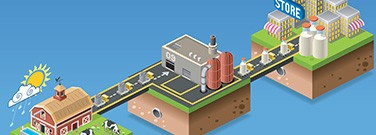Studying the Stability of the Global Food Supply Chain

By Kevin Ritchart
As the world becomes more globalized, one of the primary ways countries have come to rely on each other is through the creation of a food supply chain.
With technology allowing products to be shipped between countries around the world, food produced in one country is often consumed elsewhere.
Being a part of this intricate, interconnected network has many benefits. For instance, if the United States routinely imports food from several other countries and one of these countries stops sending food, there are typically many other places the United States can contact to obtain those same products.
Shocking the System
But, as the COVID-19 pandemic has shown us, the food supply chain can be vulnerable when exposed to unexpected changes. A recent study examined how environmental shocks affected the food supply chain and looked at ways for it to become more resilient.
The research team, whose work was published in a recent issue of Nature Food, looked at how food supply chains are still able to function during everything from floods, droughts, and extreme heat to pest infestations, disease outbreaks, and more.
Kyle Davis of the University of Delaware led the study. His team’s main motivation was to understand what’s currently known about disruptions to the food supply chain and investigate how problems at one step in the chain can affect subsequent steps.
The steps Davis and his team looked at during the study were food production, storage, processing, distribution and trade, and retail and consumption. This work is especially timely, given that the COVID-19 pandemic has shown the world how the food supply chain can still function under extreme stress.
“COVID-19 has affected all steps in the supply chain simultaneously, from not having enough seasonal workers to harvest the crops to meat processing plants temporarily closing because workers get sick, to hoarding behaviors and runs on grocery stores,” Davis said.
Keeping the Chain Connected
Overall, the goal of his team’s work is to help policy makers and businesses strengthen their supply chains and become more capable of predicting and absorbing shocks.
Future research in this area will likely include further understanding the overall number of people affected at each step of the food supply chain, the impact of multiple shocks occurring at the same time, and finding a way to quantify the countries’ abilities to substitute products when there are shortages.

